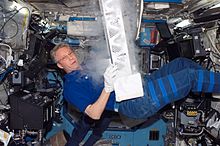
Back البحث العلمي على متن محطة الفضاء الدولية Arabic Investigació científica en l'Estació Espacial Internacional Catalan Forschung auf der ISS German
The examples and perspective in this article deal primarily with the United States and do not represent a worldwide view of the subject. (March 2022) |


The International Space Station is a platform for scientific research that requires one or more of the unusual conditions present in low Earth orbit (for example microgravity, (cosmic) -radiation and extreme temperatures). The primary fields of research include human research, space medicine, life sciences, physical sciences, astronomy and meteorology.[1][2] The 2005 NASA Authorization Act designated the American segment of the International Space Station as a national laboratory with the goal of increasing the use of the ISS by other federal agencies and the private sector.[3]
Research on the ISS improves knowledge about the effects of long-term space exposure on the human body. Subjects currently under study include muscle atrophy, bone loss, and fluid shift. The data will be used to determine whether space colonization and lengthy human spaceflight are feasible. As of 2006, data on bone loss and muscular atrophy suggest that there would be a significant risk of fractures and movement problems if astronauts landed on a planet after a lengthy interplanetary cruise (such as the six-month journey time required to fly to Mars).[4][5] Large scale medical studies are conducted aboard the ISS via the National Space Biomedical Research Institute (NSBRI). Prominent among these is the Advanced Diagnostic Ultrasound in Microgravity study in which astronauts (including former ISS Commanders Leroy Chiao and Gennady Padalka) perform ultrasound scans under the guidance of remote experts. The study considers the diagnosis and treatment of medical conditions in space. Usually, there is no physician on board the ISS, and diagnosis of medical conditions is a challenge. It is anticipated that remotely guided ultrasound scans will have application on Earth in emergency and rural care situations where access to a trained physician is difficult.[6][7][8]
Researchers are investigating the effect of the station's near-weightless environment on the evolution, development, growth and internal processes of plants and animals. In response to some of this data, NASA wants to investigate microgravity's effects on the growth of three-dimensional, human-like tissues, and the unusual protein crystals that can be formed in space.[9]
The investigation of the physics of fluids in microgravity will allow researchers to model the behaviour of fluids better. Because fluids can be almost completely combined in microgravity, physicists investigate fluids that do not mix well on Earth. In addition, an examination of reactions that are slowed by low gravity and temperatures will give scientists a deeper understanding of superconductivity.[9]
The study of materials science is an important ISS research activity, with the objective of reaping economic benefits through the improvement of techniques used on the ground.[10] Other areas of interest include the effect of the low gravity environment on combustion, through the study of the efficiency of burning and control of emissions and pollutants. These findings may improve our knowledge about energy production, and lead to economic and environmental benefits.
Remote sensing of the Earth, astronomy, and deep space research on the ISS have significantly increased during the 2010s after the completion of the US Orbital Segment in 2011. Throughout the more than 20 years of the ISS program researchers aboard the ISS and on the ground have examined aerosols, ozone, water vapor, and oxides in Earth's atmosphere, as well as the Sun, cosmic rays, cosmic dust, antimatter, and dark matter in the universe. Examples of Earth-viewing remote sensing experiments that have flown on the ISS are the Orbiting Carbon Observatory 3, ISS-RapidScat, HICO, ECOSTRESS, the Global Ecosystem Dynamics Investigation, and the Cloud Aerosol Transport System. ISS-based astronomy telescopes and experiments include SOLAR, the Neutron Star Interior Composition Explorer, the Calorimetric Electron Telescope, the Monitor of All-sky X-ray Image (MAXI), and the Alpha Magnetic Spectrometer.[9][11]
Since 2018, an example of automated manufacturing on the ISS is the testing across nine launches (as of April 2024) of a system to manufacture artificial retinas benefitted by the weightless environment.[12] Progress has resulted in a goal of beginning human trials of the material as early as 2027.[12]
- ^ "International Space Station Overview". ShuttlePressKit.com. 3 June 1999. Retrieved 17 February 2009.
- ^ International Space Station Overview Research and On-Orbit Facilities Non-Partner Participation.
- ^ "NASA Authorization Act 2005" (PDF). United States Government Printing Office. 30 December 2005. Retrieved 6 March 2009.
- ^ Buckey, Jay (23 February 2006). Space Physiology. Oxford University Press USA. ISBN 978-0-19-513725-5.
- ^ Grossman, List (24 July 2009). "Ion engine could one day power 39-day trips to Mars". New Scientist. Retrieved 8 January 2010.
- ^ Boen, Brooke (1 May 2009). "Advanced Diagnostic Ultrasound in Microgravity (ADUM)". NASA. Archived from the original on 23 August 2007. Retrieved 1 October 2009.
- ^ Rao, Sishir; et al. (2008). "A Pilot Study of Comprehensive Ultrasound Education at the Wayne State University School of Medicine". Journal of Ultrasound in Medicine. 27 (5): 745–749. doi:10.7863/jum.2008.27.5.745. PMID 18424650. S2CID 30566494.
- ^ Fincke, Michael; et al. (2004). "Evaluation of Shoulder Integrity in Space: First Report of Musculoskeletal US on the International Space Station". Radiology. 234 (2): 319–322. doi:10.1148/radiol.2342041680. PMID 15533948.
- ^ a b c "Fields of Research". NASA. 26 June 2007. Archived from the original on 23 January 2008.
- ^ "Materials Science 101". Science@NASA. 15 September 1999. Archived from the original on 14 June 2009. Retrieved 18 June 2009.
- ^ NASA.gov . Retrieved 9 December
- ^ a b Brown, David W. (May 2024). Honan, Mat (ed.). "Stations in the Sky". MIT Technology Review. 127 (3). Cambridge, Massachusetts: Technology Review, Incorporated: 54–56.